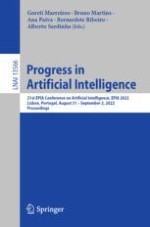This book constitutes the proceedings of the 21st EPIA Conference on Artificial Intelligence, EPIA 2022, which took place in Lisbon, Portugal, in August/September 2022.
The 64 papers presented in this volume were carefully reviewed and selected from 85 submissions. They were organized in topical sections as follows: AI4IS - Artificial Intelligence for Industry and Societies; AIL - Artificial Intelligence and Law; AIM - Artificial Intelligence in Medicine; AIPES - Artificial Intelligence in Power and Energy Systems; AITS - Artificial Intelligence in Transportation Systems; AmIA - Ambient Intelligence and Affective Environments; GAI - General AI; IROBOT - Intelligent Robotics; KDBI - Knowledge Discovery and Business Intelligence; KRR - Knowledge Representation and Reasoning; MASTA - Multi-Agent Systems: Theory and Applications; TeMA - Text Mining and Applications.
